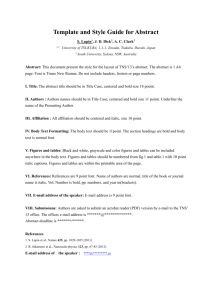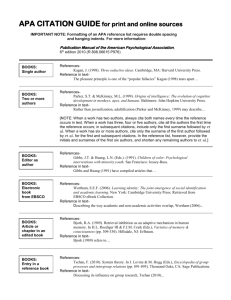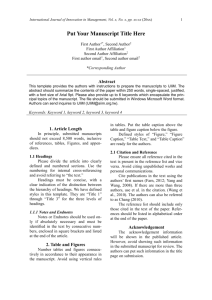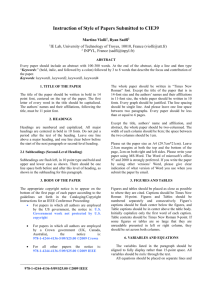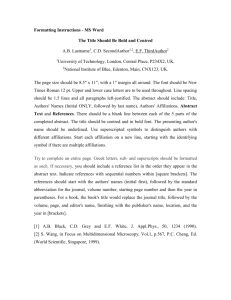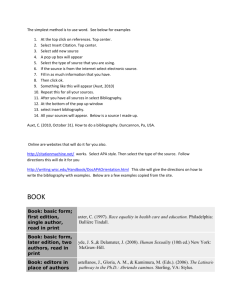Proceedings Template - Faculty Of Sport Science & Recreation
advertisement
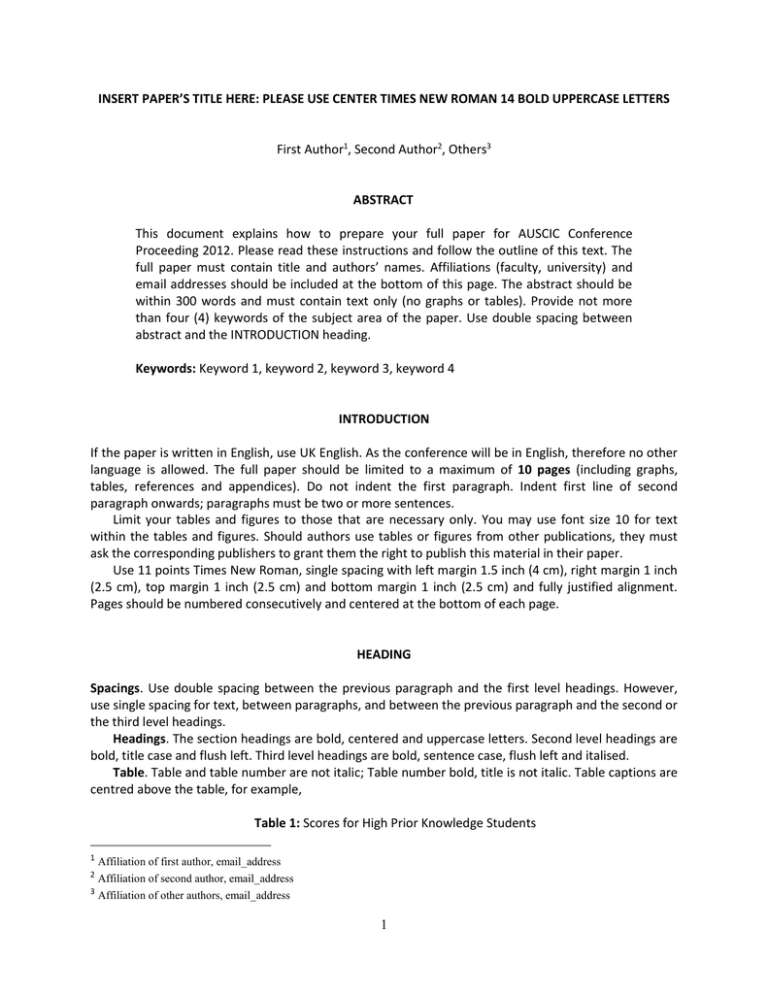
INSERT PAPER’S TITLE HERE: PLEASE USE CENTER TIMES NEW ROMAN 14 BOLD UPPERCASE LETTERS First Author1, Second Author2, Others3 ABSTRACT This document explains how to prepare your full paper for AUSCIC Conference Proceeding 2012. Please read these instructions and follow the outline of this text. The full paper must contain title and authors’ names. Affiliations (faculty, university) and email addresses should be included at the bottom of this page. The abstract should be within 300 words and must contain text only (no graphs or tables). Provide not more than four (4) keywords of the subject area of the paper. Use double spacing between abstract and the INTRODUCTION heading. Keywords: Keyword 1, keyword 2, keyword 3, keyword 4 INTRODUCTION If the paper is written in English, use UK English. As the conference will be in English, therefore no other language is allowed. The full paper should be limited to a maximum of 10 pages (including graphs, tables, references and appendices). Do not indent the first paragraph. Indent first line of second paragraph onwards; paragraphs must be two or more sentences. Limit your tables and figures to those that are necessary only. You may use font size 10 for text within the tables and figures. Should authors use tables or figures from other publications, they must ask the corresponding publishers to grant them the right to publish this material in their paper. Use 11 points Times New Roman, single spacing with left margin 1.5 inch (4 cm), right margin 1 inch (2.5 cm), top margin 1 inch (2.5 cm) and bottom margin 1 inch (2.5 cm) and fully justified alignment. Pages should be numbered consecutively and centered at the bottom of each page. HEADING Spacings. Use double spacing between the previous paragraph and the first level headings. However, use single spacing for text, between paragraphs, and between the previous paragraph and the second or the third level headings. Headings. The section headings are bold, centered and uppercase letters. Second level headings are bold, title case and flush left. Third level headings are bold, sentence case, flush left and italised. Table. Table and table number are not italic; Table number bold, title is not italic. Table captions are centred above the table, for example, Table 1: Scores for High Prior Knowledge Students 1 Affiliation of first author, email_address Affiliation of second author, email_address 3 Affiliation of other authors, email_address 2 1 Figure. Figure and figure number are not italic; Figure number bold, title is not italic. Figure captions are centered below the figure, for example, Figure 1: Graphical Representation of the Research Design Equations. Equations are numbered consecutively in Arabic numerals in parentheses on the right hand side of the page, for example, P1(r) = exp (-r/R)/R (1) References The Proceedings adopts the 6th Edition APA (American Psychological Association) referencing system. References in the text should include author’s name and publication year. Examples of citations in text One author (Bean, 1992); two authors (Graham & Krugman, 1989); more than two authors (Bernanke et al., 1999) or Bean (1992), Graham and Krugman (1989), and Bernanke et al. (1999). In the case of more than two authors, write out all of the authors’ names the first time they appear. Then use the first author’s last name followed by “et al.” To cite secondary sources, refer to both sources in the text, but include in the References list only the source that you actually used, for example, (Braun, 2008, as cited in Fielder, 2008) References must be listed in alphabetical order of first author at the end of the paper. Examples of references JOURNALS, MAGAZINES, NEWSPAPERS IN PRINT FORMAT General Form: Author, A., Author, B., & Author, C. (Year). Title of article. Title of Journal, xx (x), xxx-xxx. Article in Journal: One Author Dornbusch, R. (1976). Exchange Rate Expectations and Monetary Policy. Journal of International Economics, 6(2), 231-44. Two to Seven Authors [List all authors] Rawlings, P. K., Reguera, D. & Reiss, H. (2004). Entropic Basis of the Pareto Law. Physica A, 343, 643-652. 2 Eight or More Authors [ List the first six authors,…and the last author] Wolchik, S. A., West, S. G., Sandler, I. N., Tein, J. Y., Coatsworth, D., Lengua, L.,…Griffin, W. A. (2000). An experimental evaluation of theory-based mother and mother-child programs for children of divorce. Journal of Consulting and Clinical Psychology, 68, 843-856. Magazine article: Garner, H.J. (1997, July). Do babies have a universal song? Psychology Today, 102, 70-77. BOOKS, CHAPTERS IN BOOKS, REPORTS, ETC. General Form: Author, A. (Year). Title of work. Location: Publisher. Books: Weidlich, W. (2000). Sociodynamics: a systematic approach to mathematical modeling in the social science. Amsterdam: Harwood Academic Publishers. Mishkin, F.S. (2004). The Economics of Money, Banking and Financial Markets (7th ed.). Boston: Addison Wesley. Helpman E., & Krugman, P. (1985). Market Structure and Foreign Trade. Cambridge: MIT Press. Chapter in Book: Dornbusch, R. (1977). The Theory of Flexible Exchange Rate Regimes and Macroeconomic Policy. In J. Herin, A. Lindbeck & J. Myhrman (Eds.), Flexible Exchange Rates and Stabilization Policy (pp. 123-43). Boulder, CO: Westview Press. Conference papers: Van Vorst, S. (2000). Nursing students' and new graduate nurses' perception of challenge and support in mental health nursing. Paper presented at the 26th National Convention of Australian and New Zealand College of Mental Health Nurses, Broadbeach, Australia. Dissertation: Olsen, G. W. (1985). Campus child care within the public supported post-secondary educational institutions in the state of Wisconsin (day-care) (Doctoral dissertation, University of WisconsinMadison, 1985). Dissertations Abstracts International, 47/03, 783. ERIC Document: 3 Shyyan, V., Thurlow, M., & Liu, K. (2005). Student perceptions of instructional strategies: Voices of English language learners with disabilities. Minneapolis, MN: National Center on Educational Outcomes, University of Minnesota. Retrieved from the ERIC database. (ED495903) ONLINE JOURNALS, MAGAZINES, NEWSPAPERS General Form: Author, A., Author, B., & Author, C. (Year). Title of article. Name of Journal, xx, xxx-xxx, doi:xxxxxxxxxx Artcle Retreived from an Online Database: With DOI (Digital Object Identifier): Senior, B., & Swailes, S. (2007). Inside management teams: Developing a teamwork survey instrument. British Journal of Management, 18, 138-153. doi: 10.1111/j.1467-8551.2006.00507.x Without DOI, use the URL or web address: Koo, D. J., Chitwoode, D. D., & Sanchez, J. (2008). Violent victimization and the routine activities/lifestyle of active drug users. Journal of Drug Issues, 38, 1105-1137. Retrieved from http://www.criminology.fsu edu/~jdi/ OTHER ONLINE SOURCES General Form: Author, A. (Year). Title of work. Retrieved from web address Online Report: Kenny, G. M., Cook, a., & Pelletier, J. (2009). Prospects for reducing uninsured rates among children: How much can premium assistance programs help? Retrieved from Urban Institute website: http://www.urban.org/url.cfm?ID=411823 No Identified Author and No Date: GVU’s 10th WWW user survey. (n.d). Retrieved from http://www/cc.gatech.edu/user_surveys/survey1998-10/ If information is retrieved from an aggregated database, and the name of the database is provided and sufficient, no address is needed: Eid, M. & Langeheine, R. (1999). The measurement of consistency and occasion specificity with latent class models: A new model and its application to the measurement of affect. Psychological Methods, 4, 100-116. Retrieved from the PsycARTICLES database. Sahelian, R. (1999, January). Achoo! Better Nutrition, 61, 24. Retrieved from Academic Index. 4
